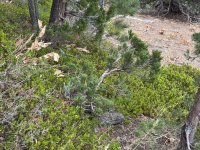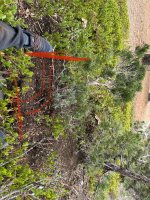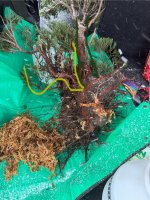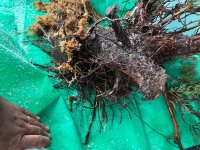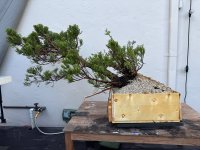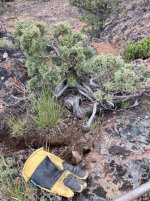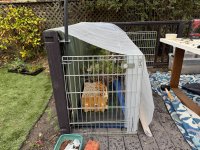MrBonsai19
Seedling
- Messages
- 7
- Reaction score
- 4
Hi Everyone,
I was hoping to get some feedback about the after-care for this collected sierra juniper as well as share what I thought was a kind of interesting formation. Firstly I will say I overcommitted myself a bit here and have learned some lessons about making good judgements and how to better preserve the root ball. I made a big mistake that cost me a lot of native soil.
That said I am doing everything I can to set this tree up for long term survival. Welcome any tips or input to give myself the best chance. I am based in Oakland, CA. The tree has been boxed up in 100% sifted pumice (large/medium size). Its been kept in shade. I would like to keep it in more sun exposure but I am limited on locations that would also provide the kind of safety from yard critters and my dog. If moving into full sun seems critical then I can try to put some kind of protective structure to make that happen but I am hoping that morning sun will be OK.
The part I thought was most interesting was that there was actually a large taproot which I didn't realize until the tree was almost fully collected was likely originating from a separate, larger tree. It seems to me the tree I collected was growing off this taproot from a tree that was likely further uphill. Has anyone seen a "root sucker" from a sierra juniper develop like this ?
I was hoping to get some feedback about the after-care for this collected sierra juniper as well as share what I thought was a kind of interesting formation. Firstly I will say I overcommitted myself a bit here and have learned some lessons about making good judgements and how to better preserve the root ball. I made a big mistake that cost me a lot of native soil.
That said I am doing everything I can to set this tree up for long term survival. Welcome any tips or input to give myself the best chance. I am based in Oakland, CA. The tree has been boxed up in 100% sifted pumice (large/medium size). Its been kept in shade. I would like to keep it in more sun exposure but I am limited on locations that would also provide the kind of safety from yard critters and my dog. If moving into full sun seems critical then I can try to put some kind of protective structure to make that happen but I am hoping that morning sun will be OK.
The part I thought was most interesting was that there was actually a large taproot which I didn't realize until the tree was almost fully collected was likely originating from a separate, larger tree. It seems to me the tree I collected was growing off this taproot from a tree that was likely further uphill. Has anyone seen a "root sucker" from a sierra juniper develop like this ?

